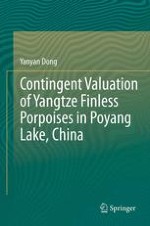2013 | OriginalPaper | Chapter
5. Results
Author : Yanyan Dong
Published in: Contingent Valuation of Yangtze Finless Porpoises in Poyang Lake, China
Publisher: Springer Netherlands
Activate our intelligent search to find suitable subject content or patents.
Select sections of text to find matching patents with Artificial Intelligence. powered by
Select sections of text to find additional relevant content using AI-assisted search. powered by
Abstract
-
Socioeconomic characteristics of the samples (Sect. 5.1 and 5.4.1).
-
Evaluation of respondents’ attitude (Sect. 5.2).
-
Validity assessment of the WTP bids (Sect. 5.3).
-
Descriptive statistical results for WTP estimates (Sect. 5.4.2).
-
Theoretical validity tests of WTP (Sect. 5.4.3).
-
Comparison of WTP bids in Beijing, Guangzhou, and Nanchang to test the distance effects (Sect. 5.4.2.1).
-
Comparison of WTP means in China and Germany (Sect. 5.4.2.2).
